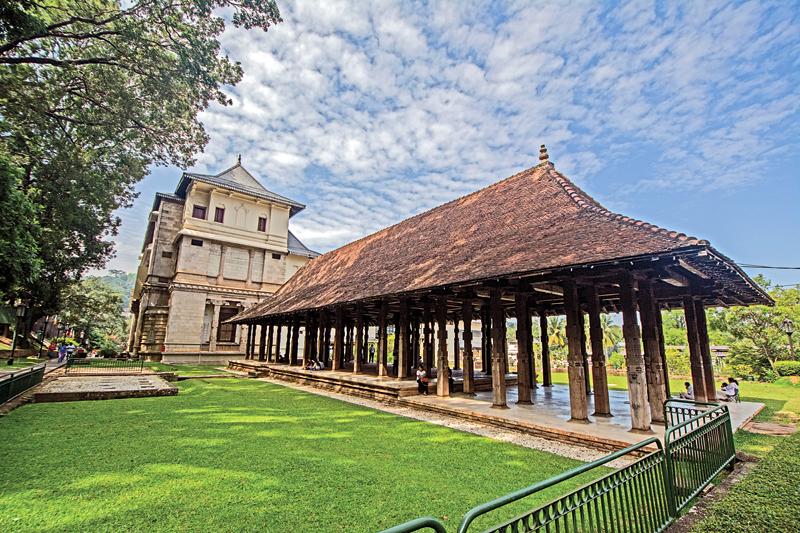
At this time of the year, during the month of Esala (July/August)the focus is on Kandy – the hill capital, because of the annual Sri Dalada Perahera. Crowds throng Mahanuwara, the capital of Kanda Uda Rata, which earned the reputation of being the last Sinhalese kingdom which kept the foreign rulers at bay for nearly 500 years.
For over 15 years, as a photographer, I had ventured into the city of Kandy during the festival season every year. Annually, during a ten-day period in August, the Sacred Tooth Relic of the Buddha is venerated with a number of great processions.
In July 2007, I made my first trip to Kandy to document this great shrine. The first journey was followed by 10 more trips in the succeeding 15 years. During that time, I photographed, researched, and wrote about this historic cultural ceremony and documented the architectural marvels of the Temple of the Sacred Tooth Relic.
Nestling below the hills, edged by a tree-fringed lake and set among the reaches of the great Mahaweli Ganga, the city of Kandy is still very much a focal point of Sri Lankan culture. It was the capital of the Kandyan kingdom and the seat of government for the last generation of Sri Lanka’s Kings, and in spite of the fall of that kingdom nearly 170 years ago, this beautiful city has preserved some of its old-world charm.
Kandy was originally known as Senkadagala after a hermit named Senkada, who lived there.
Great city
 The moat and Pattiripuwa |
To many of the Sinhala people, it is known as Maha Nuwara, the ‘great city’. But the Name Kandy was derived from the word kanda, which means mountain - an ideal name for a city 500 metres above sea level surrounded by the Knuckles, Madulkele, Dolosbage and Kotmale mountain ranges, and accessible only by a series of steep road and rail passes.
Due to its isolated location, Kandy was not an easy target for the foreign invaders who plundered the coastal regions of the island. Thus Kandyan culture was able to foster and maintain its own social structure, mode of living, art and architecture. The Kings of Kandy ensured the safety and sovereignty of the hill capital and its great culture until the city was finally captured by the British in 1815.
The Dalada Maligawa or the ‘Temple of the Tooth Relic’ is one of the most striking features of Kandy. The temple is the repository of the Tooth Relic of the Buddha. The original temple was built in 1592, and was subsequently built and rebuilt by a succession of Kings. The Pattirippuwa, the octagonal addition, was made by King Sri Wickrama Rajasingha, the last King of Kandy. (He also added the moat.) This provided a place from which he could address his subjects on important occasions. The British, for a short time, converted the Pattirippuwa into a prison, and today it houses the Temple’s priceless Oriental Library.
Architectural highlights
The painted ceiling, wood carvings and silver and ivory doors are the architectural highlights of the building. The two-storeyed temple has carved timber column beams and rafters, and the roof is covered with cool clay tiles and ‘bo tree leaf’ eaves. The beeralu balustrade on the ground floor, with its pink walls and hanging foliage pots, comes alive twice a day to the beating of the temple drums. The Magul Maduwa, or Audience Hall, a striking example of timber architecture of the Kandyan period, was a conference hall of the Kandyan chiefs.
Just East of the Royal Palace is the national museum, in the Queen’s Palace. A wonderful collection of Kandyan jewellery, artefacts and other articles can be seen here.
Most roads in Kandy are called veediyas, and in the days of the ancient kingdom those involved in similar professions lived down the same roads. The merchants lived on Hetti Veediya; the silversmiths on Ridi Veediya, and the King’s relatives on Kumaruppa Veediya.
On Raju Veediya is the beautiful Saint Paul’s, an old Anglican church featuring a 115-year-old pipe organ. Just half a block West of the church is the ‘King’s Pavilion’ – a beautiful structure built by the British Governor, Edward Barnes, that is now one of the official residences of the President.
The Malwatta and Asgiriya monasteries in Kandy take turns in conducting ceremonies in the temple. Malwatta, older of the two, may date back to the 16th century. The columns, painted ceilings, and carved beams of the Malwatta charter hall are an example of typical Kandyan architecture.
Milky Sea
The beautiful Kandy Lake is a highlight of the city. This lake was constructed by the last King of Kandy, Sri Wickrama Rajasingha. He called it Kiri Muhuda or ‘Milky Sea’, and it is said that commoners were against this project, for the King used enforced, free labour. They also did not see much use in a lake that did not irrigate the paddy fields, but the King delighted in feeding boiled rice to the multitude fish that resided there. On the island in the middle of the lake, the King built a pleasure house, Kreeda Salawa, where some say he kept his harem.
After Kandy surrendered, the British were knowm to stroll the promenade around the Kandy Lake with parasol and all. It was the British who built the wall surrounding the lake, which is known as Diyareli Bemma or the ‘wave swell’ wall. The niches in the parapet are intended for clay oil lamps.
During the Esala Perahera, which takes place this year from August 10 to 19, this city with its niched parapets and clay lamps becomes an incredible city of dazzling lights.
The Colonial architecture is still very evident in Kandy. The Queens Hotel and Hotel Suisse exemplify some of the British influences and preserved their unique culture, and Kandyans with their own style and flair produced a great civilisation that is still very much alive.

